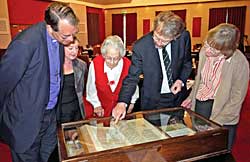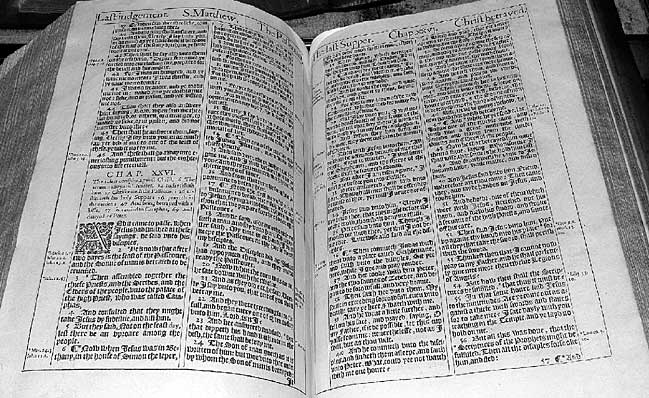Articles from the Thoroton Society Newsletter
The Beeston Bibles

Inspecting the Beeston Bible at the Luncheon with verse 36 being pointed out by Professor John Becket. L to R: Bishop Paul Butler, Barbara Cast, Rosalys Coope, John Beckett and Dorothy Johnston (Photo: Howard Fisher).
Our guest at the Annual Luncheon spoke about the King James Bible and we were fortunate to have an example of this book on display. This bible was found in Beeston church over a hundred years ago and the story of its discovery was given in an article in the Thoroton Transactions issue 6 in 1902 by George Fellows (pp 25-28). The article is reproduced below, in part, because of the interest in the 400th anniversary of this version of the bible.
A FIND OF OLD BIBLES AT BEESTON
In the account of the visit of the Thoroton Society to Burton Joyce in the 1898 volume of Transactions, it is mentioned, on page 31, that there was at Beeston Church, a black leather Bible similar to the one then shown to the members. The attention of the vicar of Beeston, Rev. Arthur C. Beckton, was called to this fact in 1902, and, after much search, he discovered two such Bibles lying discarded in a chamber in the belfry.
They are both Bibles of the "Authorised Version", issued by order of King Kames l. One is of the first issue, with all the errors which are characteristic of that edition; the other is of a subsequent issue, in which the errors of the first have been corrected, except the two in Ezekiel. Unfortunately neither Bible is in perfect condition.
The older Bible, when found, was bound in rough calf with brass corners. The title page, the address of the translators, some of the pages of the Genealogies, and everything subsequent to Revelation xviii., 12, is missing. The title page of the New Testament reads as follows:
THE
NEWE
TESTAMENT OF
IESUS CHRIST
¶ Newly translated out of
the Original Greek: and with
the former Translations diligently
compared and revised by his
Maiesties special com-
andment
¶ Imprinted
at London by Robert
Barker, Printer to the Kings most excellent
Maiestie Anno Dom: 1611

The bible on display at the lunch. Look closely at verse 36 to see one of the errors - where 'Judas' is printed instead of'Jesus'.
The above occupies the centre of the page, and is surrounded by an elaborately executed woodcut showing the four Evangelists, with their respective symbols, at the corners. On the right side are the names of the twelve Apostles; on the left side, those of the twelve Tribes with their tents and distinctive badges; at the top is the word Jehovah in Hebrew characters. The text is black-letter, the chapter headings and marginal references in Roman type, and the alternative readings in italics. It contains the Apocrypha, a complete Almanac; table of proper Lessons, and part of "the Genealogies recorded on Sacred Scriptures, according to every famiiie and tribe with the Line of Our Saviour, Jesus Christ, observed from Adam to the blessed virgin Marie by J.S. cum privilege."
Unfortunately, the title and some other pages of the Genealogies are missing. The covers measure 18 by 11^ inches, and the volume is 3% inches thick.
This Bible is known as the 'HE' Bible, a name arising from the error in Ruth, 111., 15, where "he wente into the cities" appears instead of she. This error is rectified in the later or 'She' Bible issue.
In the later volume at Beeston Church, the first leaf of the address "The Translators to the Reader" is mutilated, and everything beyond Revelation xx., 12, is lost. As in the earlier book, the title page of the Old Testament is missing. The title page of the New Testament is similar to that in the original volume, except that the words "appointed to be read in Churches" appear, and in the list of the books of the Bible an error has crept in, which is not in the earlier issue, viz, I and ii, Chronicles are given as I and ii Corinthians. This volume was bound in oak boards, beveled from front to back and on the inside edges, covered in unstained white calf, "blind-tooled", with brass mountings. Straps instead of clasps were used to fasten both books.
These books are now in the hands of Mr. John Castor, bookbinder, of Beeston, who is taking great interest in the work of restoring and repairing them, under the supervision of the vicar.
... Any reader wishing for still fuller information should refer to the book "Old Bibles" by Dore (Eyre and Spottiswood, 1888) Much of the foregoing information has been gathered from this source.
A conference was held at Hampton Court between the Church and the conforming Dissenters on January 16th, 17th and 18th, 1604, at which Dr. Reynolds, the leader of the Puritan party, suggested that a new translation of the Bible be made, and the conference "moved His Majesty that there might be a new translation of the Bible because those which were allowed in the reign of King Henry VIII and Edward VI were corrupt and not answerable to the truth of the Original." To this, King James assented.
There were fifty-four translators appointed, who were divided into six companies. They met at Oxford, Cambridge and Westminster, and wisely decided to introduce as little change as possible into the Bishop's Bible i.e. the Bible, which hitherto was usually read. Their translation was, and still is, known as the "Authorised Version".
GEORGE FELLOWS
Ed: The section omitted in the above lists the errors in the first issue of the bible; any member interested to see what these were can read the Transactions a copy of which is in the Reading Room at Nottinghamshire Archives with copies also being in other repositories.
< Previous